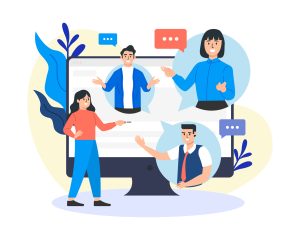When employees are given an opportunity to learn in a way that accommodates them and their specific needs, they will feel valued. eLearning at work can help organisations to empower employees to take charge of their development trajectory, driving the cultivation of a learning mindset and fostering a motivated and engaged workforce.
How can employees benefit from eLearning at work?
- Online learning suits everyone
- On-demand access to learning
- Seamless delivery of activities
- Relevant and timely learning content
- Reduced costs
- eLearning is environmentally friendly
- eLearning eliminates the need to be local
1. Online learning suits everyone
The digital transformation has forever changed the way learners consume content. The rise of integrated digital technology has led organisations to reconsider the way they deliver mandatory and non-mandatory learning activities, and how they support an array of learning styles. In fact, “increasing digital learning resources and introducing new training techniques” are priorities for over 80% of decision-makers, according to this survey.
Social learning is the idea that we learn by watching others. Also known as social cognitive theory, it is one of the longest-standing learning styles, but one of the most under-utilised in a remote work setting. But it can be built into eLearning content programmes through gamification – incorporating game-design-inspired elements and principles into a non-gaming context, such as rewarding learners for positive interactions, using progress or status bars, and providing instant feedback.
Not only does eLearning accommodate various learning styles, but it also supports an array of eLearning content formats. eLearning content can be delivered through traditional text-based mediums such as blogs and guides; it can also be presented in a video, podcast or audio recording, and even in highly interactive formats like quizzes and puzzles.

2. On-demand access to learning
Online lessons are accessible at any time, allowing every learner to consume learning content at their preferred pace. Employees are used to being able to consume content whenever they like outside of work – think watching TV shows on catch up rather than live – and will appreciate the same flexibility when it comes to learning.
eLearning allows learners to revisit activities and content at any time, which often leads to higher knowledge retention rates and increased levels of completion and compliance. If a learner knows they can access their learning material at any time, from any device, anywhere in the world, it makes sense that they are more likely to complete their training.
This is especially useful for neurodiverse employees who may have fluctuating energy and focus throughout their days and working weeks, as well as anyone with a busy schedule.
Offering on-demand access to activities also gives learners autonomy. It’s rare that any two learners have the same level of understanding on any given topic, which may lead to feelings of inferiority or pressure to upskill too quickly. eLearning prioritises the learning, engagement, and retention of every employee, regardless of their starting point. This helps to foster feelings of inclusiveness while supporting the learning needs of individuals.
Unlimited access helps learners fit their training in to their work day more effectively. Rather than blocking out days at a time, learners can choose to work through the sections in a logical, practical way that considers their workload. When an employee has control over when (and how) they consume learning content, they’re better equipped to retain and implement their newly acquired knowledge and skills.

3. Seamless delivery of activities
When we remove the time-consuming elements typically associated with in-person training, we can quickly see one of the biggest advantages of eLearning: speed of delivery. Learning content can be delivered in an instant, shortening time to completion, and improving the overall workflow of a learning journey.
Learners no longer need to contend with the off-topic conversations that are typical of an in-person training event, and, with fewer distractions, the time taken to consume and retain information is reduced.
Other than an unreliable internet connection hampering an employee’s access, activities are usually delivered reliably and without delay. This adds to a positive user experience and increases the likelihood of employees completing each journey.
eLearning is to workplace training what email was to the written letter, and organisations; it is, simply put, the future of modern organisational learning.

4. Relevant and timely learning content
Updating eLearning content take just a few clicks, while traditional forms of learning content – such as printed workbooks – are costly to replace when they become out of date, both in terms of financial cost and environmental impact.
As learning objectives evolve, so too can the supporting content. Sections can be added, removed, and updated in real-time, giving learners immediate access to the most up-to-date content. This allows the learner to feel empowered by removing the friction of potentially investing hours into learning and retaining content that’s no longer relevant.
Meanwhile, Microlearning – the concise, short-form version of ‘traditional’ eLearning – offers precise learning activities and even narrower objectives. Typically, microlearning content is a short video lasting no more than 15 minutes, and can help employees save time (and cognitive load) when completing specific training.
Related: Realising your ‘people potential’ through skills gap analysis >

5. Reduced costs
eLearning drastically reduces costs for both learners and organisations. Learners enjoy the financial freedom of not needing to commute to a location each day – often requiring only a device and an internet connection to complete their training activities.
Accommodation in large cities is often a crippling commitment, especially with many training courses requiring two or three days away from the office. By removing the need to travel and overnight in often expensive lodgings, learners are more likely to undertake non-mandatory training. Employees with caring responsibilities also benefit from the removed need to travel for training, alleviating unnecessary stress and freeing up more time to focus on actually learning. This is one of the less noticeable benefits of eLearning, which also holds the most potential to create a learning culture where employees strive to go above and beyond because of how convenient it is to upskill themselves.

6. eLearning is environmentally friendly
Perhaps a culmination of the advantages listed above, the environmental impact of eLearning is considerably lower than face-to-face learning events.
We can consider the below environmental factors negated (or, at least, minimised) when prioritising eLearning over in-person learning:
- Carbon emissions from train, bus, air, and road travel
- Heating and cooling costs for venues
- Plastic and paper waste from catering and refreshment supplies for the duration of the event, not to mention the additional travel for catering deliveries
- Food waste, also associated with higher catering costs for an array of dietary requirements
- Accommodation costs, typically a burden on gas and electricity resources
The environmental impact of in-person training events soon becomes overwhelming, considering how frequently new learning material needs to be delivered.
Related: The A-Z of eLearning terminology >

7. eLearning eliminates the need to be local
Organisations (and employees) have benefitted from the global shift to remote and home-based working. This has filtered through to eLearning, removing the restrictions of physical location.
Learners no longer need to be local – opening both the talent pool as well as the ability to deliver quality learning content across continents and time zones.
eLearning also enables an element of social learning, which is vital for driving engagement and cultivating inclusion in the workplace. By removing the need to be physically present, learners are more inclined to interact within their own comfort levels while pushing their learning and development further.
Evidently, the advantages of eLearning for employees underpins the growing need for digital transformation in the workplace. Learning and development should be at the forefront of employee training strategies.
eLearning is the way forward
Employees will sooner resign than accept rigid, traditional working environments. Organisations must implement accessible learning opportunities as part of their employee experience and development initiatives. If you’re ready to explore the potential of a highly configurable, intuitive, and personalised LMS system, request a demo today.
Related reading:
This article was first published on Digits.co.uk – a Ciphr Company.
